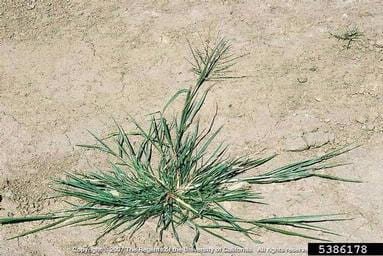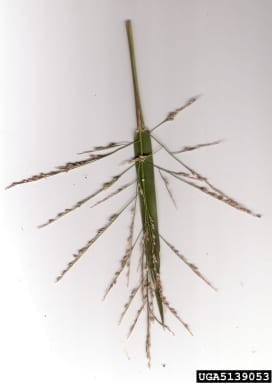Scientific name: Panicum dichtomiflorum
Other names: smooth witchgrass, western witchgrass, sprouting crab-grass
Fall Panicum (Panicum dichtomiflorum), a summer annual, is originally native to North America and is found across the U.S. It is a problematic weed in agricultural settings, such as small fruit (berries), field crops (corn and soy), and vegetable systems in NYS. It can be a harvest impediment in late sweet corn systems. It can also be a problem in horticultural crops, turfgrass and other landscapes. This grass also has a distinguishable growth habit as it bends at its nodes, which establishes a zigzag pattern.
Identification
Seedlings: The shape of the leaf bud is rolled. On young seedlings the leaf blade is hairy on the lower surface and are slightly purple.
Seedling leaf blade size: 0.25 inches (0.6 cm) wide by 0.75-1.5 inches (1.9-3.8 cm) long
Midrib of fall panicum.
Photo by Randy Prostak of UMass Extension Landscape, Nursery and Urban Forestry Program
Management
Chemical control
See Cornell’s Turfgrass and Landscape Weed ID for more weed ID and chemical management information. It should be noted that fall panicum is not as sensitive to glyphosate compared to other grasses. Use CCE Eastern NY Horticulture’s herbicide lookup tool to find the efficacy of various herbicides on fall panicum. For general guidance on weed control, get the latest edition of the Cornell Crop and Pest Management Guidelines.
Non-chemical control
Crop rotation is paramount in controlling fall panicum. Germination does not occur until the soil warms, if winter grains or spring grains are planted early they can compete and suppress this grass. Preventing seed development is also crucial for blocking more spread. Cover cropping can be used to compete with this grass. When managing within a vegetable crop system, a short season crop that is harvested in the late summer before fall panicum starts to form seed will upset the grass’s life cycle if the field is properly cleaned right after harvest. When growing row crops, using tine weeding pre- and postemergence, and covering seedlings with soil in the row is effective if crop can tolerate this technique. Another method that may work better is separating the shoot and root, which results in minimal soil upset. Long season row crops tend to have supportive conditions for fall panicum growth if cultivation is inefficient. Avoid soil compaction and poor drainage as these are good conditions for fall panicum.
Natural enemy:
P. dichtomiflorum has a natural enemy, smut fungus (Ustilago destruens), which affects seed production.
Similar species
Table 8: Compares the Panicums: fall panicum (Panicum dichtomiflorum), switchgrass (Panicum virgatum), and witchgrass (Panicum capillare) illustrating their similarities and differences.
| Species | Fall panicum (Panicum dichtomiflorum) | Switchgrass (Panicum virgatum) | Witchgrass (Panicum capillare) |
|---|---|---|---|
| Similarities | Summer annual; leaf bud rolled; no auricle; ligule fringe of hairs; fibrous root system | Leaf bud rolled; no auricle; ligule fringe of hairs | Summer annual; leaf bud rolled; no auricle; ligule fringe of hairs; fibrous root system |
| Differences | Seedling leaf sheaths are densely hairy, blades are hairy on lower surface; mature blades and sheaths are smooth on both surfaces. | Perennial; leaf blade is hairy on upper side; sheath is hairy at margins; it produces rhizomes | Seedling sheath, blade, and collar are densely hairy; on mature plant, leaf blades on both surfaces and leaf sheaths are densely hairy |
Herbicide resistance in fall panicum
Reported as of 2021:
North America
None
Other continents
Europe
Group 5 (Spain)
For a more detailed report, please visit the reference section below or visit the International Herbicide-Resistant Weed Database homepage for more information: http://www.weedscience.org/Home.aspx
References
For control tactics for fall panicum check out the University of Delaware Cooperative Extension blog post.
For an IPM focused discussion look at the University of Missouri’s IPM blog post on fall panicum.
For more information please look the upcoming book, Manage Weeds on Your Farm: A Guide to Ecological Strategies by Charles L. Mohler, John Teasdale, and Antonio DiTommaso (Publisher: SARE Outreach, expected late fall of 2021).
Uva R H, Neal J C, DiTomaso J M. 1997. Weeds of the Northeast. Book published by Cornell University, Ithaca NY. The go-to for weed ID in the Northeast; look for a new edition sometime in 2019.
Cornell University’s Turfgrass and Landscape Weed ID app. Identification and control options for weeds common to turf, agriculture, and gardens in New York; uses a very simple decision tree to identify your weed.
Herbicide resistance details
North America
None
Other continents
Europe
Spain, group 5 (atrazine)








